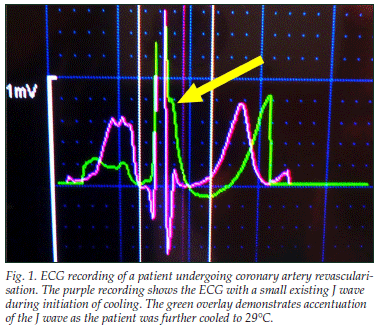Serviços Personalizados
Artigo
Indicadores
Links relacionados
-
 Citado por Google
Citado por Google -
 Similares em Google
Similares em Google
Compartilhar
SAMJ: South African Medical Journal
versão On-line ISSN 2078-5135
versão impressa ISSN 0256-9574
SAMJ, S. Afr. med. j. vol.100 no.6 Pretoria Jun. 2010
FORUM
CLINICAL IMAGES
The progression of a J wave during induction of hypothermia
Reitze Nils Rodseth
J waves can commonly be seen in patients with severe hypothermia. Fig. 1 shows an ECG recording of a patient undergoing coronary artery revascularisation with the use of cardiopulmonary bypass. The purple recording shows the ECG with a small, existing J wave early during the initiation of cooling. The green overlay demonstrates the accentuation of the J wave as the patient was further cooled to 29ºC.

The J wave (also known as the Osborn wave) is often seen in hypothermia and in hypercalcaemia. It has been described in patients with early repolarisation syndrome, Chagas' disease and Brugada syndrome. The proposed mechanism for J wave development is cold-induced accentuation of the action potential of M and epicardial cells, creating the J wave. Additional conduction delay from endocardium to epicardium then moves the J wave out of the QRS complex.1 J waves in most cases of hypothermia resolve on return to normothermia, but may persist in some patients. Other ECG changes that may be seen in hypothermia include flattening of the p wave and QT prolongation.
1. Yan GX, Antzelevitch C. Cellular basis for the electrocardiographic J wave. Circulation 1996; 93(2): 372-379. [ Links ]
Dr Rodseth is an anaesthetic specialist in the Department of Anaesthetics at Inkosi Albert Luthuli Central Hospital, Nelson R Mandela School of Medicine, University of KwaZulu-Natal, Durban.
Corresponding author: R Rodseth (reitzerodseth@gmail.com)














